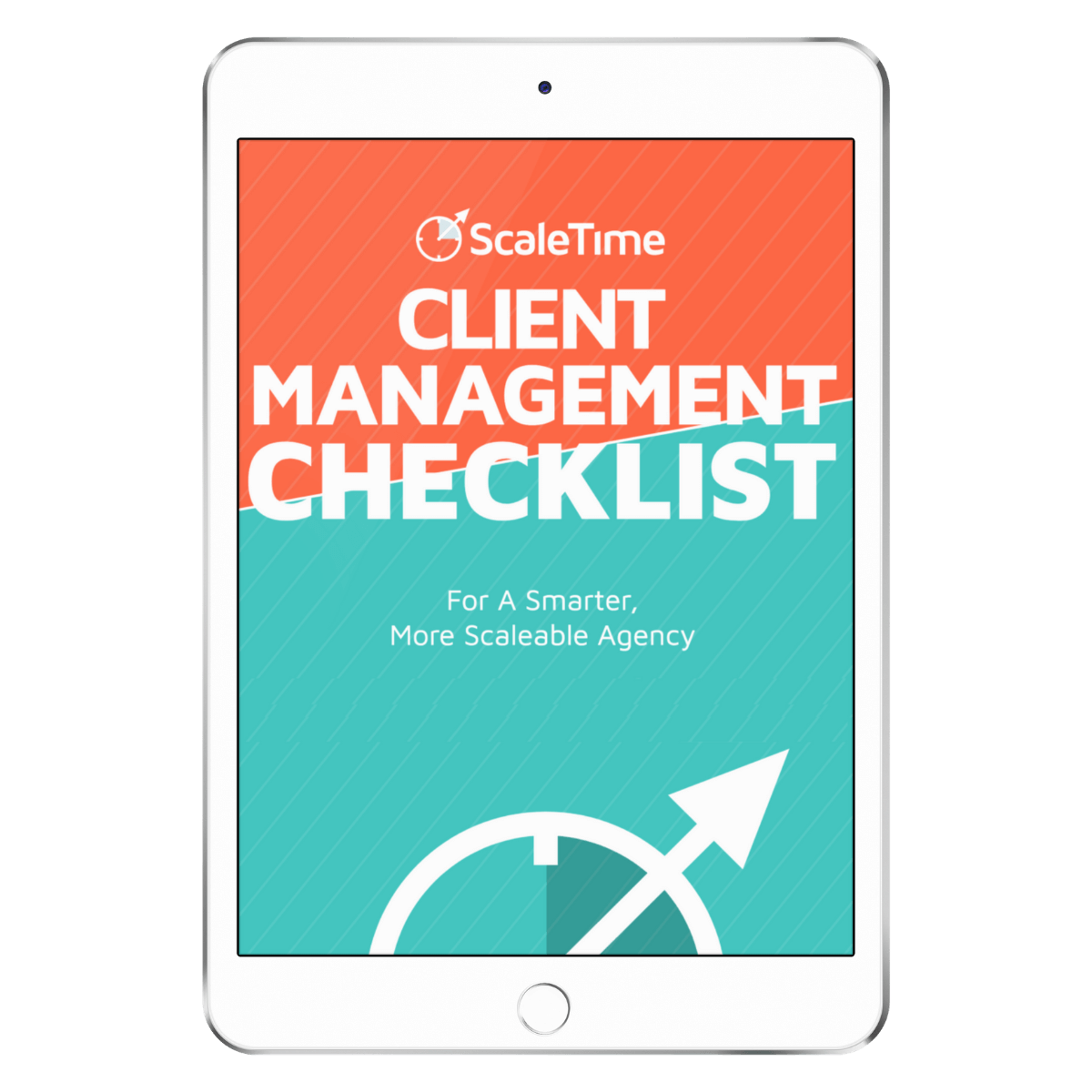
Picture this: You’ve onboarded a fantastic client. You’re psyched to get started and it’s time to hand the project off to the account manager.
The next step is easy: everyone can just jump right in and start cracking on those deliverables! Time to pour yourself a cold one.
* record scratch *
Eh, not so fast there, Kemosabe.
Shut the fridge door! Before you get started, you need to hold a project kick-off meeting.
Okay, what is this and why do you need it?
A successful project kickoff meeting is a critical step in any successful project. It gets your whole team on the same page, aligns the sales team, account manager, project manager, and deliverables team, and helps avoid unnecessary (and time-consuming) bottlenecks.
Sound good? Yeah, it’s a pretty great tool for scaling. But most importantly, a project kick-off meeting helps you avoid dreaded, costly, frustrating scope creep.
Nobody got time for that.
During a project kickoff meeting, you’ll cover topics like:
- What exactly did sales promise the client?
- Are there any special considerations for the client or project?
- What’s the expected turnaround time?
Think about it: how can your team run a successful project that leaves the client happy without a project kickoff meeting? Skip that step, and you’re missing a crucial part of the delivery process.
Fortunately, it’s easy to run a successful project kick-off meeting that leaves every member of your team informed, aligned, and ready to dive in and get things done. The result is promises delivered and happy clients for your agency.
Ready to learn more about how you can master the project kickoff meeting process? Get the scoop below.
Table of Contents
What’s a Project Kickoff Meeting?
Why do you need a project kickoff meeting agenda anyway?
Sample Kickoff Meeting Agenda
No leaving the room without a clear-cut action plan.

What is a Project Kickoff Meeting?
A project kickoff meeting is the first meeting between the client and the team working on the project.
Wondering when to hold a kick off meeting? Great question.
Typically, it takes place after the agency has officially onboarded a client. Your team and the client have already agreed on project details like the scope of work and the budget.
So where does a kick off meeting fit into the equation? The kick off meeting is your time to learn as much as you can about the client, their expectations, and their goals.
A well-organized project kick off meeting agenda covers topics like:
- The project’s main objectives
- Team members’ primary responsibilities
- The high-level scope of the project
- Assumptions that went into the planning process
- The proposed schedule for delivery and review
In a lot of cases, there’ll be more topics covered in a project kickoff meeting. But apart from defining the whats and whys, a project kick off meeting should also cover the hows, providing a clear direction and strategy for the project in question.
Who Should Attend the Meeting?
Put your dancing shoes on ‘cause it’s a kickoff meeting partay! Who should get an invite?
As a general rule, project kick off meetings should include everyone involved in the project. Or anyone who has a (direct or indirect) interest in it.
This list isn’t exhaustive, but the following people should probably get an invite:
- The Project Team: The project team is your group of full-time and part-time team members who are working on the deliverables associated with the project. Depending on the type and scope of the project, this might include copywriters, designers, and project and account managers.
- Project Sponsor: The project sponsor is the person (typically an executive) responsible for managing, administering, funding, and monitoring the project. To put it another way: the project sponsor is the person who makes sure work is getting done and that the project is on-track for delivery.
- Project Stakeholders: The project stakeholders are the specific group of people who have an internal or external interest in the project’s successful outcome. These people may be your project team members or members of the client’s creative team.
While this is a general outline of the people who should be included in a project kick off meeting, it’s important to remember that each meeting and project is different. Include anyone who is important to the project and its successful completion.
Why do You Need a Meeting Agenda?
The start of a new project can feel a little overwhelming. There’s a lot of information flying around. You’re dealing with a new client, a new project, a new set of goals, and a lot of metrics and KPIs in-between.
Is chaos inevitable? No way.
It’s processes that bridle the chaos, and turn it into an organized system so creativity can flow.
The best way to keep that information organized and make sure you don’t miss anything during the project kick off meeting is to create a project kick off meeting agenda.
Here are a few benefits of flexing a meeting agenda:
- Increased clarity about the project, goals, and deliverables
- A second (and third, and fourth) set of eyes on the project to make sure all questions are answered and details covered
- The development of important next steps — including a project execution plan and direction
Good news, Amigo. You don’t have to start your kickoff meeting agenda from scratch. Let’s take a look at a few kickoff meeting use cases and sample agendas you can adapt for your agency.
Sample Kickoff Meeting Agenda: 5 Key Steps to Follow
While every project is different, it pays to have a well-defined structure before starting any kickoff meeting.
Here’s the project kick off meeting template I swear by:
Step #1: Introduce the Team and Client
The effective kickoff meeting is a great time to make introductions. With that in mind, begin the meeting by congratulating everyone on the new external project and thanking them for their time.
To ensure everyone is on the same page at the start of the meeting, ask a few key questions:
- Has everyone been introduced?
- Does everyone understand everyone else’s role in the project?
- Is everyone familiar with the project’s deliverables and scope?
- Does everyone understand the position of this project in the larger context of the company?
If the project involves people who have never worked together before, take some time to introduce everyone, provide some project background, and explain how each team member fits into the project in question.
Step #2: Cover the Project Summary
You issued an intake form during the client onboarding process right? Be sure to do that. Because now’s the time to look over the responses.
This will help put the project in context and ensure everyone on your team understands things like:
- What the project entails
- Why it matters
- Why it’s important to your client and team
- Who the end-user of the site, product, content, etc. will be
- Potential risks, constraints, difficulties, or roadblocks involved with the project
If there are any questions regarding the intake form or project summary, this is a great time to address them.
Step #3: Drill Down on the Approach
Typically, your agency will have already hammered out a Scope of Work (SOW) agreement before you sit down at the internal project kickoff meeting. Still, a successful kickoff meeting should cover the high-level scope of the project and, more importantly, the approach you plan to take to tackle the project.
Because most of the time, by the time they pay you they not only forgot what they paid you for and they want it done yesterday. #TheStrugleIsReal sooo…
Here are a few questions to ask and answer about the project scope:
- What are the milestones and their delivery dates?
- What tools, software, or platforms will you use to complete the project?
- How will you address bottlenecks, time crunches, risks, compliance issues, etc. associated with the project?
- Which team members or departments need to work together and communicate to get the project done?
Let the client know how your business and services work and agree upon the project scope.
Go through the project timeline, estimates, statements of work, and anything else that’s applicable.
Remember your project management checklist? It was born for this. Get it out and start using it.
Step #4: Define Team Roles

For a project to run smoothly, everyone needs to understand who’s supposed to be doing what, and when. To this end, acknowledge your team’s unique assortment of skills, and be sure everyone understands their role on the project.
Before you leave the kickoff meeting, attendees should know:
- What they’re supposed to be working on (including key milestones, the expectations for those milestones, and target delivery dates)
- The KPIs or metrics that will be used to track success on those deliverables
- Who else on the team they need to work with
If anyone has questions about their role or position in the project, answer them during this phase.
Step #5: Outline Clear Next Steps
Next, come up with a project management plan to ensure that each attendee knows what comes next and what’s expected of them to drive the project to fruition. Set-up full project clarity before impatience takes over the meeting.
Make a plan for keeping everyone on the same page. This is the part where you talk about the collaboration tools you’ll be using, like Slack and Asana. You’ll also want to address how you’ll handle client questions that will inevitably arise during the project.
Discuss and clear misunderstandings regarding project objectives. Get all the questions out of the way before you start cracking on deliverables.
Bottom line: leave nothing to the imagination.
Wrapping up
To put it plainly: a project kickoff meeting is a must-do any time you start a new job.
In addition to helping you avoid unnecessarily time-consuming and (yikes) embarrassing miscommunications, a kickoff meeting puts every team member on the same page and makes it much easier to hit the ground running.
You can’t just waltz, or rather, stumble, into a client kickoff meeting unprepared.
Instead, you need a project kick off meeting agenda. An airtight and scalable kickoff meeting agenda keeps you and your team on track and all bases covered. Oh, and bonus — it makes your team look good, too.
Okay, let’s review your action steps:
- Introduce the team and provide background
- Review the project summary and client onboarding form responses
- Define and align the approach and scope of the project
- Specify roles, deliverables, and tools used to get the job done
- Plan to collaborate, communicate, and get started on the next steps
While no two project kick-off meetings are the same, the template above is flexible enough to adapt for any meeting. The idea is that it provides a strong foundation to build from and customize. With this template, you’ve got a decent starting point every time you sit down to meet with a client.
Are you ready to execute your projects like a pro and scale up your business like never before? Check this case study on how a divorced single mom of two turned her side project into a growing business.





















%20(1).gif)
